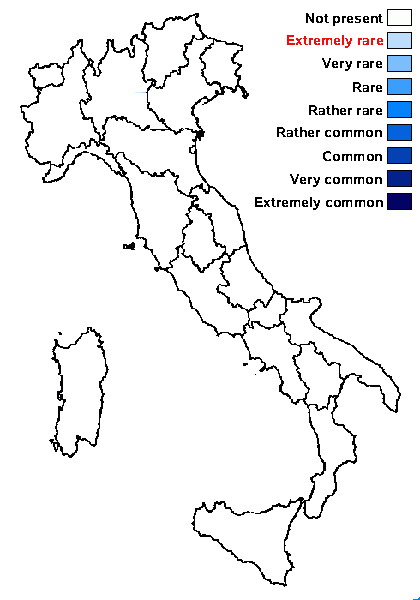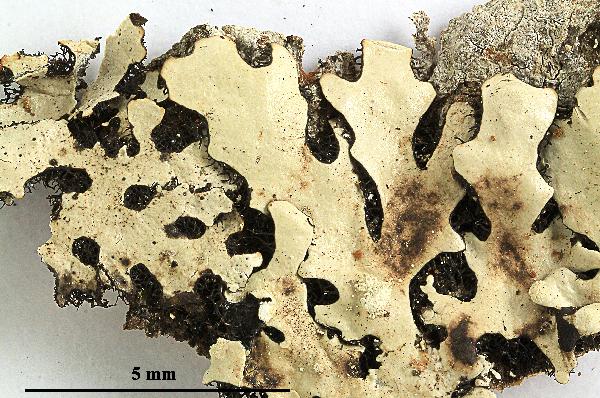Hypotrachyna lividescens (Kurok.) Hale
Phytologia, 28, 4: 341, 1974. Basionym: Parmelia lividescens Kurok. - in Hale & Kurokawa, Contr. U.S. Natnl. Herb., 36: 181, 1964
Synonyms:
Distribution:
Description: Thallus foliose, heteromerous, dorsiventral, closely adnate, forming more or less regular, 3-8(-10) cm wide rosettes, sorediate. Lobes 1-3(-4) mm wide, subdichotomously branched with rounded axils and truncate to subrotund tips, linear-elongate, more or less crenulate, flat to slightly convex, separate to contiguous; upper surface very pale ash-grey (sometimes almost whitish), emaculate, smooth to somewhat rugulose, dull but shiny in younger lobes, irregularly cracked in older lobes, with laminal or subterminal, orbicular to subcapitiform, sometimes confluent soralia bearing whitish to greenish, farinose soredia; lower surface black in central parts, brown at margins, usually shiny, with sparse to moderately dense, short, black, more or less shiny, dichotomously branched rhizines which sometimes project beyond lobe margins. Upper cortex of tightly packed, anticlinally oriented hyphae, with a pored epicortex, the cell walls with isolichenan; medulla white; algal layer continuous; lower cortex brown, of anticlinally oriented hyphae. Apothecia rare, lecanorine, laminal, substipitate, 2-5(-8) mm across, with a dark brown disc and a sorediate, crenulate thalline margin. Epithecium brownish; hymenium and hypothecium colourless. Asci 8-spored, clavate, Lecanora-type. Ascospores 1-celled, hyaline, broadly ellipsoid, 9-13 x 5-8 µm. Photobiont chlorococcoid. Spot tests: upper cortex K+ yellow, C-, KC-, P- or P+ faintly yellow, UV-; medulla K-, C+ blood-red turning orange-red, KC+ orange-red, P-. Chemistry: upper cortex with atranorin and chloroatranorin; medulla with olivetoric acid (major), anziaic acid (minor) and traces of other substances.
Note: a mainly epiphytic species known from South Africa, Australia and Western Europe, in France extending from the Atlantic coasts to Provence; to be looked for in Tyrrhenian Italy.
Growth form: Foliose
Substrata: bark
Photobiont: green algae other than Trentepohlia
Reproductive strategy: mainly asexual, by soredia, or soredia-like structures (e.g. blastidia)
Most common in areas with a humid-warm climate (e.g. most of Tyrrenian Italy)

Predictive model

United States National Herbarium - Smithsonian (US:Lichens) - Type Status: Isotype
Collector: O. Almborn Number: 9490 Date: 1953-11-10 Locality: South Africa, KwaZulu-Natal, Polela, Polela Forest. - CC BY-NC 3.0 - Source: Consortium of Lichen Herbaria (2023) http//:lichenportal.org/portal/index.php. Accessed on December 18.
Growth form: Foliose
Substrata: bark
Photobiont: green algae other than Trentepohlia
Reproductive strategy: mainly asexual, by soredia, or soredia-like structures (e.g. blastidia)
Most common in areas with a humid-warm climate (e.g. most of Tyrrenian Italy)

Predictive model

 INDEX FUNGORUM
INDEX FUNGORUM
 GBIF
GBIF




